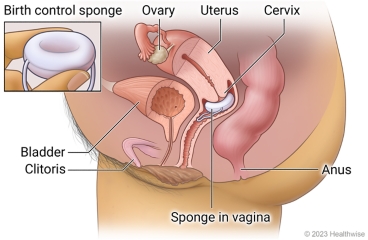What is the sponge?

The sponge is used to prevent pregnancy. It is called a barrier method because it keeps the sperm and eggs apart. The sponge also contains a spermicide, which kills the sperm or stops the sperm from moving.
The sponge fits inside your vagina and covers the cervix, which is the opening of the uterus. After you place the sponge, you have protection for up to 24 hours. You must leave the sponge in place for 6 hours after vaginal sex. Don't leave it in for more than a total of 30 hours.
Be sure to tell your doctor about any health problems you have or medicines you take. Your doctor can help you choose the birth control method that is right for you.
How well does it work?
How well the sponge works depends on whether you have ever delivered a child vaginally.
- If you have had a vaginal childbirth:
- When the sponge is used exactly as directed, it is about 80% effective for preventing pregnancy. This means that about 20 out of 100 people who use it will have an unplanned pregnancy. When it is not used exactly as directed, it is about 73% effective. This means that about 27 out of 100 people who use it will have an unplanned pregnancy.
- If you have not had a vaginal childbirth:
- When the sponge is used exactly as directed, it is about 91% effective for preventing pregnancy. This means that about 9 out of 100 people who use it will have an unplanned pregnancy. When it is not used exactly as directed, it is about 86% effective. This means that about 14 out of 100 people who use it will have an unplanned pregnancy.
There is less chance of getting pregnant if you and your partner use an external (male) condom with the sponge.
What should you think about when using the birth control sponge?
Some pros of using the birth control sponge
- The sponge is available without a prescription at family planning clinics, in drugstores, online, and in some grocery stores.
- The sponge doesn't use hormones. So you can use the sponge if you don't want to take hormones or can't take hormones because you have certain health problems or concerns.
- The sponge is safe to use while breastfeeding.
- It doesn't affect your menstrual cycle.
- It costs less than hormonal types of birth control.
- The sponge can be inserted up to 24 hours ahead of time so you don't have to interrupt sex.
Some cons of using the birth control sponge
- The sponge doesn't prevent pregnancy as well as IUDs or hormonal forms of birth control.
- It prevents pregnancy only if you use it every time you have vaginal sex.
- The sponge doesn't protect against sexually transmitted infections (STIs), such as herpes or HIV. If you're not sure whether your sex partner might have an STI, use an external (male) condom to protect against infection.
- The spermicide in the sponge can cause irritation to the vagina or penis and can increase your risk for urinary tract infections.
- You may have to interrupt sex to insert the sponge.
- You may not be comfortable with inserting the sponge each time you have vaginal sex.
- You cannot use the sponge during your period.
How do you use the sponge?
Read the instructions that come with the sponge. If you don't use it correctly, you could get pregnant. To more effectively prevent pregnancy, use an external (male) condom with the sponge.
- You can insert the sponge up to 24 hours or right before having vaginal sex.
- After vaginal sex, leave the sponge in for 6 hours.
- The sponge should not be left in longer than a total of 30 hours.
If you think you used the sponge incorrectly, you can use emergency contraception. The most effective emergency contraception is an IUD (inserted by a doctor). You can also get emergency contraceptive pills. You can get them with a prescription from your doctor or without a prescription at most drugstores.
Where can you learn more?
Go to http://www.healthwise.net/patientEd
Enter E545 in the search box to learn more about "Learning About Birth Control: Sponge".
Current as of: May 5, 2025
Author: Ignite Healthwise, LLC Staff
Clinical Review Board
All Ignite Healthwise, LLC education is reviewed by a team that includes physicians, nurses, advanced practitioners, registered dieticians, and other healthcare professionals.

